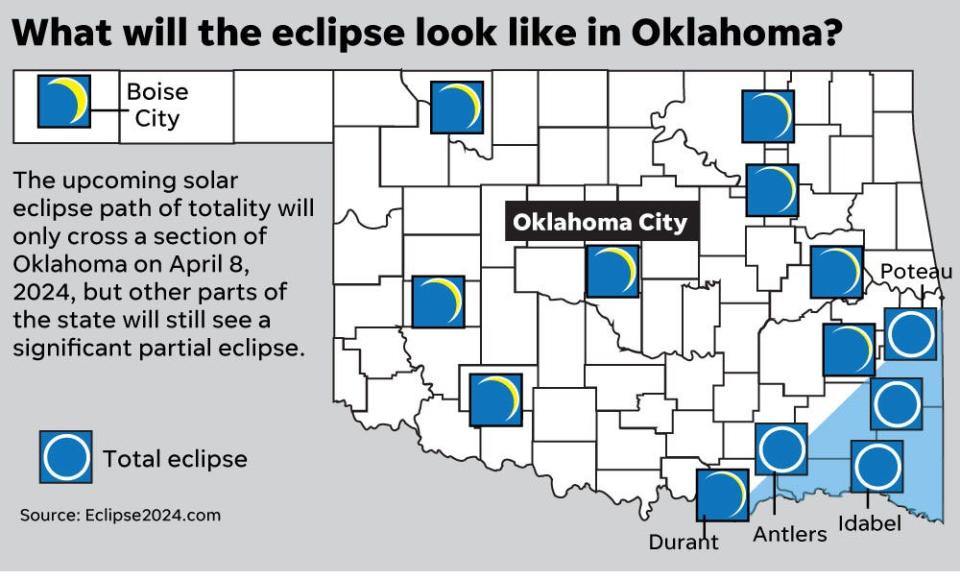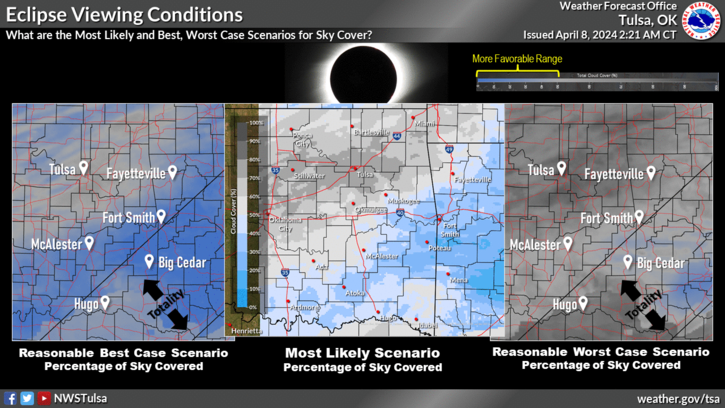Did you see it? 2024 total solar eclipse peak passes over Oklahoma, clouds hold off
An extraordinarily rare event took place this afternoon as the moon's shadow passed over southeastern Oklahoma, giving those in the path of a total solar eclipse an incredible show.
Oklahoma City still saw an impressive partial eclipse beginning around 12:30 p.m. with the peak at 1:45 p.m.
The entire path of totality, where the moon completely blocks the sun, was seen by millions of people as it crossed over San Antonio, Austin, Dallas, Idabel, Little Rock, Indianapolis, Cleveland, Buffalo and Montreal.
Do not look directly at the sun without specialized protective eyewear. Looking at the sun during a partial eclipse can cause severe and permanent eye damage. Sunglasses will not protect you. Even welding goggles might not be strong enough to block the full spectrum of the sun's powerful radiation.
A total solar eclipse can only be viewed with the naked eye during totality, which typically lasts just a few minutes and only in specific areas.
More: What time is the solar eclipse? Search your ZIP code for a viewing guide
Crowd at Science Museum Oklahoma wowed by eclipse
Dozens of families were out at Science Museum Oklahoma on Monday afternoon to witness the partial solar eclipse. Several telescopes and eclipse-viewing devices were set up outside.
Kenda Davenport was out with her daughters, Taylor and Selah Hall.
"I wanted to have this experience with them," Davenport said.
As they waited in line for a telescope to view a sliver of the sun peeking out from behind the moon, Davenport asked her girls, ages 13 and 15, to make a pledge that they'll make plans for the next total solar eclipse coming through Oklahoma in 2045.
"Promise me right now you're gonna take my grandbabies to see it, wherever it is. A hundred percent," she said.
-Dale Denwalt
Total solar eclipse has reached Oklahoma
The moon's umbra (the shadow of totality) crossed over southeastern Oklahoma at approximately 1:44 p.m.
In communities outside the path of totality, the partial eclipse will last about two and a half hours, and the show will be over by 3 p.m. Click here to get precise eclipse times for your location.
-Cheyenne Derksen
Total solar eclipse has reached Mexico on its way to Oklahoma
Totality has made landfall at Mazatlán, Mexico.
The moon's umbra (the shadow of totality) is now racing northeast at the equivalent of over 1,500 miles per hour, and will reach southeastern Oklahoma at approximately 1:44 p.m.
-Dale Denwalt
Live eclipse viewing: Watch the 2024 solar eclipse live
The eclipse has begun; partial eclipse now visible in Oklahoma
In Oklahoma City, the moon has begun to obscure, or occlude, the sun's disk. If you have an eclipse viewer or special eclipse glasses, you can now begin to see the the first little nibble.
The partial eclipse will last about two and a half hours. Peak viewing in Oklahoma will happen around 1:45 p.m., and the show will be over by 3 p.m. Click here to get precise eclipse times for your location.
-Dale Denwalt
Highway Patrol reports traffic congestion on interstate
Traffic is already starting to become congested, according to the Oklahoma Highway Patrol.
Eclipse-watchers from around the country are converging on the path of totality, which cuts across the southeast corner of Oklahoma. Expect some of the worst traffic after 2 p.m. when totality has passed through the area.
Be safe out there.
Traffic is getting congested on I-40 eastbound at the Sallisaw exit near the Arkansas border. Remember to get to a safe place off roadways to view the eclipse. We’re monitoring traffic and working to keep it flowing smoothly. pic.twitter.com/JG5u1q3BNy
— OK Highway Patrol/DPS (@OHPDPS) April 8, 2024
-Dale Denwalt
What is an 'umbra?' – and other eclipse words
Astronomers and eclipse enthusiasts are using a bunch of specialized words today. Here are a few of them and what they mean, according to the American Astronomical Society.
Bailey's Beads – This refers to the beaded appearance of the moon's edge as the eclipse nears totality. Shafts of sunlight shine through deep valleys on the moon's surface, which causes the effect known to observers as Bailey's Beads.
Corona – The sun’s upper atmosphere, visible as a pearly glow around the eclipsed sun during totality.
Partial eclipse – A solar eclipse where the moon covers only a portion of the sun. A partial eclipse precedes and follows totality or annularity, but a partial can also occur by itself.
Shadow bands (or snakes) – Very faint, shimmering ripples of dark and light moving across the ground, walls, or clouds. These hard-to-see bands result from atmospheric “twinkling” of the thin solar crescent just before and after totality. They’re best seen against a white background.
Totality – The maximum phase of a total solar eclipse, during which the moon’s disk completely covers the sun's bright face. It can last from a fraction of a second to a maximum of 7 minutes 31 seconds, depending on viewing location and other factors.
Umbra – The darkest part of the moon’s shadow, within which the entirety of the sun's bright face is blocked. An observer standing in the umbra sees a total solar eclipse.
-Dale Denwalt
Severe weather risk tonight in southern Oklahoma
If you're planning on staying in southern Oklahoma after the eclipse this afternoon, be aware that severe weather is predicted in the evening hours.
According to the National Weather Service in Norman, severe weather could form after 8 p.m. While the tornado risk is low, hail and high wind has been forecast for much of the state south of Interstate 40.
Here is the latest update concerning this evening's severe weather risk. pic.twitter.com/BATULLAWLO
— NWS Norman (@NWSNorman) April 8, 2024
-Dale Denwalt
Where can I watch the eclipse in OKC?
While you can watch the eclipse from anywhere you can see the sky, Science Museum Oklahoma at 2020 Remington Place is set up today with several ways to improve your viewing experience. No admission is required for outside activities.
Telescopes with special filters will be set up in front of the museum for viewing the eclipse safely, and materials will be provided so that visitors can create their own eclipse viewer.
Check inside for eclipse-related activities and live feeds from the path of totality.
-Dale Denwalt
What time does the eclipse start in Oklahoma?
Can't see our graphics? Click here to reload the page.
What time is the eclipse in Tulsa, Oklahoma?
The eclipse will enter Oklahoma as it crosses the Red River at about 12:27 p.m., and exit the state at about 3:07 p.m., according to National Eclipse. The total eclipse, the direct casting of the moon's shadow, will only last from about 1:44 p.m. to 1:51 p.m.
Though the path of totality only crosses a portion of the state, other cities will still have a spectacular view.
In Tulsa, the eclipse will start at 12:30 p.m., peak around 1:48 p.m., and end at 3:07 p.m.

-Cheyenne Derksen
Oklahoma eclipse weather, clouds outlook

The National Weather Service in Tulsa said there's a moderate to high likelihood the low cloud cover will remain north of the path of totality, which includes a chunk of southeast Oklahoma.
Thick, upper level clouds could stay mostly north as well, leaving mostly thinner cloud conditions across southeast Oklahoma, allowing for the eclipse to be seen through the clouds in these areas and in areas to the northeast.
According to USA Today, low clouds are the worst clouds for an eclipse. Wispy, high cirrus clouds would still allow the eclipse to be seen from the ground, while cumulus clouds are more unpredictable.
There is also a threat of severe storms expected in southern Oklahoma starting around 9 p.m. Monday night.
-Jana Hayes
Live look at Oklahoma road conditions
What color clothes are best for the solar eclipse? Purkinje effect
Thanks to a phenomenon known as the Purkinje Effect, our eyes are more sensitive to cooler colors rather than warm colors in low light.
In the four to five minutes before the total eclipse, which is called the mesopic vision zone, your surroundings will start to appear less colorful, turning grayish or silvery.
This will especially be noticeable with warm colors, but cooler colors like green are "going to pop and look brighter against the dimming surroundings," according to Solar Eyeglasses.
To experience the effect, scientists recommend wearing reds and greens to enhance your eclipse viewing experience.
"This Purkinje effect during the coming eclipse will turn the whole experience from just watching the sky go dark to a real-life science demo on your clothes," a Solar Eyeglasses spokesperson said. "But to really see the changes in color saturation, lots of people need to wear these complimentary red and green colors. Two or five in a group of 100 wouldn’t help."
-Dale Denwalt
This article originally appeared on Oklahoman: Recap: 2024 solar eclipse today in Oklahoma

